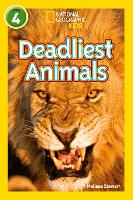


|
|
| book details |
Deadliest Animals: Level 4 (National Geographic Readers)
By (author) Melissa Stewart, By (author) National Geographic Kids

|
| on special |
normal price: R 376.95
Price: R 338.95
|
| book description |
National Geographic Primary Readers pair magnificent National Geographic photographs with engaging text by skilled authors to help your child learn to read. Developed by education experts, this series of books for beginner readers is spread across four levels: Early Reader, Becoming Fluent, Becoming Independent and Independent Reader. Did you know that a tiny golf ball-sized creature called the blue-ringed octopus contains enough venom to kill 26 adult humans? Or why the Sydney funnel web spider is one of the most dangerous creatures in the world? In this National Geographic Kids Level 4 Reader, children will be fascinated by 12 species that you hope you’ll never come across! Sharks, snakes, jellyfish and more – these creatures are among the most threatening – and interesting – in the world! Level 4: Independent Reader books are perfect for kids who are reading on their own with ease and are ready for more challenging vocabulary with varied sentence structures. They are ideal for readers of White and Lime book bands for guided reading. For another National Geographic Level 4 Reader, try Elephants (9780008266813).
| product details |

Normally shipped |
Publisher | HarperCollins Publishers
Published date | 2 Oct 2017
Language |
Format | Paperback / softback
Pages | 48
Dimensions | 229 x 152 x 4mm (L x W x H)
Weight | 90g
ISBN | 978-0-0082-6680-6
Readership Age |
BISAC | juvenile nonfiction / animals / insects, spiders, etc.
| other options |
|
|
|
To view the items in your trolley please sign in.
| sign in |
|
|
|
| specials |
|
|
Let's stare the future down and, instead of fearing AI, become solutionists.
|
This first comprehensive biography of Cecil Rhodes in a generation illuminates Rhodes’s vision for the expansion of imperialism in southern Africa, connecting politics and industry to internal development, and examines how this fueled a lasting, white-dominated colonial society.
|
|
|
|
|